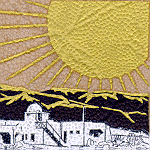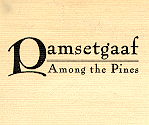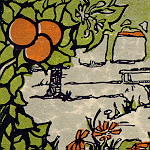

The Land of Sunshine
Introduction
Climate is among the oldest of man's experiments in the treatment of diseases. At the turn of the century it was believed that the right climate, good food and rest could cure many illnesses including, tuberculosis, upper respiratory diseases and arthritis. At that time tuberculosis was known as the 'White Plague' and was one of the most common and most life threaten diseases. Early experiments in its treatment included convalescent care and sabbaticals to the Southwest because of the benefit of its arid climate. Health-seekers came to the Southwest from all over the country in the hope that the desert air and life-giving sunshine would, if not cure, then arrest, their illnesses.
The Atchinson, Topeka and Santa Fe Railroad Company was one of the earliest promoters of the Southwest for health. They opened the Montezuma Hotel in Las Vegas, New Mexico in 1882 primarily because of the local healing hot springs. Beginning in the mid-1890's their promotional literature included climate conditions and business opportunites for those looking to relocate for health reasons. Writers and artists, like Alice Corbin Henderson and her husband, the painter William Penhallow Henderson, also discovered the healing qualities of the Southwest's climate and encouraged other artists to move west.
Promotional literature from states, cities and private sanatoriums boasted of their great locations, temperate climates and wide open spaces. Pure air, endless sunshine and restful conditions were emphasized. Our selection of advertising brochures produced by the early sanatoriums emphasize these benefits.
Sanatoriums in those days offered a full range of accommodations. Some believed that tent camping in the higher elevations offered the best possible cure, with no other treatment except open air and sunlight. Others, like the Desert Sanatorium and Institute of Research, offered full medical supervision and experimental treatments with heliotherapy (solar radiation) and diet. The Castle Hot Springs of Arizona experimented with hydrotherapy in their natural pools.
The cure for many of the early medical diseases eventually came through
scientific research, but the Southwest's climate offered health-seekers
at that time relief and comfort. Even without suffering a major illness,
our brochures from this era tempt the reader to seek the glorious health-building
sunshine and restful conditions offered by the Southwest.
In order to view the following files you must have an Acrobat Reader.
If you do not possess this software please consult the
About
the PDF link. To view a larger color image of one page of the pamphlet in JPEG, click on any image thumbnail. To view the whole pamphlet as PDF (color or black-and-white), click on the linked call number next to the thumbnail.
 [The Desert Sanatorium and Institute of Research]
[The Desert Sanatorium and Institute of Research]
The Desert Sanatorium and Institute of Research
[Tucson, Arizona]
1929, 32 pages
V9791 Pam. 42
Part
1, [3.2 MB] Part
2 [3 MB]
The Desert Sanatorium and Institute of Research was an early Tucson medical and research center operating during the latter 1920's. The non-profit 120-bed facility was devoted to the treatment of the chronic diseases of bronchitis, asthma, emphysema, sinusitis, arthritis and polio. The desert's dry air and warm climate were believed to be beneficial to the treatment of these conditions. The center had advanced research instruments like solar radiometers and a siderostat. This brochure beautifully illustrates the grounds and facilities with images by Tucson's noted photographer Al Buehman.
 Pamsetgaaf - Among the Pines
Pamsetgaaf - Among the Pines
San Francisco: Sunset Publishing House
Circa 1913, 18 pages
V9791
Pam. 2 [1.8 MB]
This promotional pamphlet highlights Pamsetgaaf, a private cottage sanatorium located outside of Prescott, Arizona. Pamsetgaaf notes its locational benefits of living high (elevation 5350 feet) among the oaks and pines of the central plateau as factors in its claim to the treatment of tuberculosis. The pamphlet describes the accommodations as like a summer camp. "The majority of those who come to Pamsetgaaf are in need, not of luxury, but of the simple life and the accommodations are designed to meet this need. Consisting of porch cottages and bungalows, raised some three feet from the ground and provided with broad verandas, where the patient spends all his time, they suggest a summer camp rather than a sanatorium."
 Castle Hot Springs, Arizona
Castle Hot Springs, Arizona
Chicago and New York: Rogers & Company
Circa 1907, 33 pages
L9791 C353 Pam.
2 [3.4 MB]
Castle Hot Springs was a fall, winter, and spring resort "of the highest class" for health, recreation and rest. It was renowned for its hot mineral waters. The resort's location offered a delightful climate, moderate elevation, the medicinal properties of the hot springs, a dry invigorating atmosphere and low humidity. It claimed to help a long list of conditions including, rheumatism, gout, anaemia, asthma, hay fever, stomach and digestive disorders. Hydrotherapy was practiced in its natural pools.
 [Women's Home Missionary Society of the Methodist Episcopal Church]
[Women's Home Missionary Society of the Methodist Episcopal Church]
Methodist Deaconess Sanatorium for Tuberculosis
Albuquerque, New Mexico: Valliant Printing Co.
Circa 1924, 14 pages
F804 A3 M4
Pam [1.5 MB]
The Methodist Deaconess Sanatorium opened in 1912 in Albuquerque, New Mexico. This pamphlet describes and photographs the facilities for prospective patients. The sanatorium consisted of three main buildings and forty-nine one-room cottages. The city of Albuquerque is described as being "a mile nearer to heaven" and offering the best climate in the world for the cure of tuberculosis.
 Albuquerque Civic Council
Albuquerque Civic Council
Putting 4-Wheel Brakes on Tuberculosis
Albuquerque, New Mexico: Albuquerque Civic Council
1925, 28 pages
F804 A3 A32 Pam [4.2 MB]
We have only exhibited the cover and introductory page of this
promotional
brochure describing the health benefits of Albuquerque, New Mexico. Written
by the Albuquerque Civic Council, the booklet places Albuquerque in the
"heart of the health country". When the pamphlet was written
in 1925 there were five major and ten minor sanatoriums and dozens of boarding
houses catering to health-seekers. Besides promoting the climate of Albuquerque,
the writers also provide a prospective visitor with descriptions of the
town's industries, schools, and attractions.
 Arizona Sanatorium and Touring Company
Arizona Sanatorium and Touring Company
Prospectus of The Arizona Sanatorium and Touring Company, Inc.
Los Angeles: "Wood's" Red Seal Print
Circa 1900s, 15 pages
V9791 Pam.
1 [0.8 MB]
This pamphlet is a prospectus for the Arizona Sanatorium and Touring Company, Inc. The facility was to be located "Among the Pines" in Pine Dale, northern Arizona. The prospectus describes the location as within a few miles of two of the recognized seven wonders of the world and the most beautiful in the Southwest. Plans for the sanatorium included a touring company which would take the patients on outings and camping parties. The patients' facilities were very basic consisting of tents, but the other planned facilities included a ballroom, billards, museum, target shooting, and gymnasium.
 [F.H. Redewill, B.S., M.D.]
[F.H. Redewill, B.S., M.D.]
Desert Inn
Phoenix, Arizona: R.A. Watkins Printing Co.
Circa 1910s, 14 pages
V9791 Pam. 38
Part 1 [2.2 MB], Part 2 [2.7 MB]
The Desert Inn of Phoenix, Arizona is described as a "haven of rest on the highway to health." This pamphlet is illustrated with photographs of the facility. The "inn" offers complete medical facilities as well as recreational activites on its 100 acre development. It caters to tuberculosis, bronchial and pulmonary cases. It offers every modern convenience with two-room cottage bungalows. "You will never know what you have missed until you have 'slept out' in a cottage or bungalow at Desert Inn." It quotes Stevenson as saying, "What seems a kind of temporal death to people choked between walls and curtains, is only light and living slumber to the man who sleeps afield. All night long he can hear Nature breathing deeply and freely, even as she takes her rest, she turns and smiles."
 [Sisters of St. Joseph of Carondelet]
[Sisters of St. Joseph of Carondelet]
St. Mary's Hospital and Sanatorium
[Tucson, Arizona]
Circa 1910s, 11 pages
V9791 S146 [2 MB]
A short distance from Tucson's St. Mary's Hospital was their sanatorium. The Sisters of St. Joseph of Carondelet opened the hospital in 1880. The sanatorium was a unique structure designed as a perfect two-story rotunda with an inside courtyard enclosing a garden. Patient rooms had verandas on the interior and exterior sides of the rotunda. The sanatorium was described as an extended family. "The spirit of sincere friendship, mutual assistance and encouragement prevails among the members of 'Saint Mary's' family. All are made to feel at home, and the 'loneliness of hospital life' is forgotten amid the cheerful surroundings".
 John Bret Harte, editor
John Bret Harte, editor
The First Fifty Years of St. Luke's-in-the-Desert
[Tucson, Arizona]
[1972], 30 pages
V9791 Pam. 34 [1.5 MB]
St. Luke's in the Desert was a tubercular sanatorium opened in 1918 by the Right Reverend Julius W. Atwood, D.D., Bishop of the Protestant Episcopal Missionary District of Arizona. Bishop Atwood recognized a need to provide affordable convalescent care for men of limited means and needing an opportunity to regain their health. The facility operated until the 1940's when tuberculosis declined as a prevalent disease. At that time it changed its focus to chest diseases and respiratory ailments and created the St. Luke's-in-the-Desert Chest Disease Center. This center eventually moved to the University of Arizona's Medical Center. We have reproduced the first six pages describing the early history of the sanatorium.
Introduction | Accessibility | Advertising | Agriculture | Architecture | Entertainment | Environment
Exotic | Health | Indigenous Culture | Railroads | Religion | Roads
